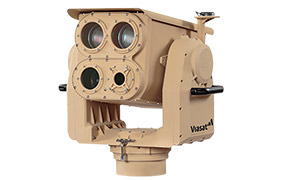Radar target detection using fractal dimension
Automatic target detection in a radar image represents a complicated task, particularly when assessing a battlefield situation over large areas to locate individual targets in the presence of heavy returns, or ‘clutter.’ Various statistical approaches have been proposed to address the clutter problem. Among them, neural network techniques have been widely adopted because of numerous advantages. Also, recent studies have shown that clutter can be modeled as a nonlinear deterministic dynamical system,1 making it amenable to chaotic system methods. We have found that combining these two approaches allows us to effectively suppress clutter and preserve target features.
We applied a dynamic learning neural network2 (DLNN) to reconstruct clutter dynamical models. A DLNN is a multilayer perceptron neural network with two modifications. First, each node in the input and hidden layers is fully connected to the output layer. Second, the activation function is removed from each output node, allowing the chaotic model to be expressed as a linear function of the output weight vector in terms of polynomial basis functions.3
Clutter signals can be reconstructed from time series measurements by applying the results of Takens4 to determine a suitable embedding dimension. As a rule, embedding size grows with model complexity, as do the number of required measurements and computational costs. Alternatively, in the approach we adopt, the clutter may be treated as a spatial chaotic system because of the nature of scattering and its associated nonlinear wave phenomena.5 This allows the clutter to be reconstructed in the spatial domain, generally with less effort. We therefore employed spatial information, rather than radar time series, in applying the DLNN.
To further ease the computational burden, we used fractal dimension5 to quantify the chaotic behavior of the clutter's geometric aspects. We determined it by differential box counting,6 the least complex of several methods used to estimate an image's fractal dimension, and easy to implement. Our proposed target detector employs DLNN in conjunction with the estimated fractal dimension to perform detection under various clutter depths.
We evaluated this method using the Moving and Stationary Target Acquisition and Recognition SAR (synthetic aperture radar) image data set.7 The images were acquired in the X band with 1ft spatial resolution. Four images of high levels of detection difficulty were selected to verify and validate the proposed approach, and the probability of false alarm was set to 0.02. Figure 1 shows the application of our method to one of the images, as well as the applications of the conventional constant false alarm rate (CFAR) algorithm and DLNN alone. Similar outcomes were obtained for the other three images.

Our approach—Figure 1(d)—yields the least noise over the whole image—Figure 1(a)—implying that the detected target is not scattered over the surroundings. The use of DLNN only—Figure 1(c)—provides satisfactory performance. It leaves some noise, but better preserves target structures, as seen by comparison with the CFAR method results shown in Figure 1(b). The balance between background noise removal and structure preservation may be adjusted by the threshold value.
The results shown in Figure 1 were assessed with the detection rate (DR), false detection rate (FDR), and loss detection rate (LDR), which measures the overlap between actual and detected target areas.8 Generally, higher DR values, and lower FDR and LDR values, denote improved performance. Table 1 shows that on this basis, our ‘DLNN+Fractal’ method was superior to DLNN alone, which was itself better than the CFAR algorithm. The conventional approach did poorly in identifying the target structure because it could not suppress the strong clutter surrounding the target.

It is obvious that the use of fractal information with a neural network does well in extracting target features amid heavy clutter. Its performance can be tuned with the threshold setting to preserve target structure and suppress background noise. The optimum threshold has yet to be determined, but we do know that it seems related to target size and image resolution.
Yu-Chang Tzeng is a professor in the Department of Electronic Engineering at the National United University. He is an adjunct researcher at the Center for Space and Remote Sensing Research, National Central University. His major research has been in the areas ofmicrowave remote sensingwith emphasis on neural network applications, and remote sensing image processing. In addition, he has written numerous papers for SPIE conferences.
Since 1992, Dr. Chen has been with the faculty of the Center for Space and Remote Sensing Research at the National Central University, where he is now a professor. He is a senior member of the IEEE, and a member of the Electromagnetic Academy. He has authored three book chapters, more than 60 referred journal papers, and 110 conference papers in the areas of remote sensing and wave scattering and propagation.



